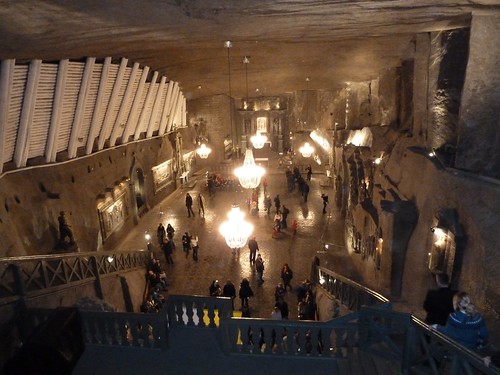Wieliczka salt mine and the methane burners

Imagine this for a job. You get to crawl through newly opened tunnels in the local salt mine. You’re dressed in heavy wool clothes which you have soaked in water before starting. Your job is to find methane deposits and deliberately set them off with a burning faggot on the end of a long pole you push before you.
People have been mining the Wieliczka salt mine since prehistory. They started out extracting salt from salty springs by boiling the water in clay pots. When the waters started to lose their salt, the locals started digging wells. Eventually the wells became mines and rock salt was being extracted directly. For millennia this was done by hand in pretty terrible conditions. On its face it was marginally better than a coal mine or a metal mine because the salt allows you to dig out caverns rather than follow narrow seams – but that’s really only a relative improvement. It was hard work in tough conditions to say the least.
One interesting fact was that the salt was mined into columns rather than cubes. The columns were about a meter long and the salt was carried closer to the surface by being rolled over the mine pathways up to the lifting device. The chips were collected into 30kg sacks and carried by workers up steps on a piecework basis – up the steps lugging a sack, back down the path to get another and then back up again, and again. Starts to make setting off methane deposits sound like career advancement, doesn’t it?
The Wieliczka salt mine is huge, there are over 350km of tunnels of which your compulsory tour takes you through about 4km. The mine is quite interesting in terms of ancient mining but the real claim to fame are the caverns and carvings done by the workers in their down-time. Unfortunately, most of the carvings we saw were done in the last 20-60 years. Jennifer and I visited the mine about 20 years ago and had memories of seeing delightfully slumped carvings from a hundred and more years ago; sadly none of those were on the tour.
Wieliczka has been a destination for a long time, Copernicus even visited back in the early 1500s, so they’ve become adept at providing a tourist experience. The compulsory tour involves stops at underground souvenir and coffee shops. There’s something a bit strange and compelling about a coffee shop 150m underground. Given the mine was always the major employer in the area and shut down as an active mine in 1996, it’s hard to begrudge the locals their effort to extract a tourist dollar; and they do it with some charm. When we passed an underground lake with the inevitable coins tossed into it our guide suggested that people tossed money in for luck but “The only people getting lucky are the workers assigned to clear out the coins every now and again. Better you buy something in the souvenir shop and help all of us.”
The Wieliczka salt mine is the second salt mine we’ve visited so far this year, so we’re feeling a little bit like experts. It’s very, very different to the Hallein mine and, honestly, if by some weird twist of fate you had the choice between the two we’d recommend Hallein every time. Hallein is more fun and feels more like a real experience – you come away with some sense of what working in the mine was like. Seeing Wieliczka’s underground churches and restaurants is entertaining, but you can’t help but wonder what the methane burners would have thought of it all.
_____________________________________________
Practical things for those who may come after:
1. There’s absolutely no need to get one of the package tours advertised everywhere in Krakow. The tours seem to go for about 100Zl. The compulsory mine tour is about 50Zl. We got a bus there from the train station for 3Zl and a train back for 5Zl. Not a huge saving when converted into a harder currency, but there’s simply no real benefit in handing over the extra to a tour operator.
2. The mine tour lasts 3 hours thanks to a recent decision to make a visit to the museum at the end compulsory. That’s about an hour-and-a-half too long. We insisted on skipping the museum and continued our insistance in spite of the guide’s polite but strong reluctance to let us get on the elevator that you have to pass on your way to the Museum. In the end we did ‘escape’ before the Museum. That was still a 2-hour tour and that’s more than enough with kids. It’s not the length or the distance involved so much as the lack of variety – after the first five or six carvings the novelty has gone for the kids.
Good post and excellent advice. I enjoyed the trip but did find it a bit tedious towards the end.
Wieliczka Salt Mine is such beautiful place to visit – it’s true gem of Polish travel destinations 😉 great post, thanks!